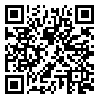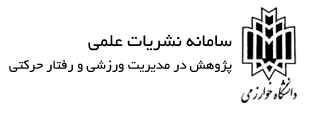دوره 15، شماره 29 - ( 2-1404 )
جلد 15 شماره 29 صفحات 104-85 |
برگشت به فهرست نسخه ها
Download citation:
BibTeX | RIS | EndNote | Medlars | ProCite | Reference Manager | RefWorks
Send citation to:



BibTeX | RIS | EndNote | Medlars | ProCite | Reference Manager | RefWorks
Send citation to:
Babapuor M, Dehghanizade J. The Role Of Autonomy In Motor Learning: An Exploration Of The OPTIMAL Theory And Self-Controlled Learning. JRSM 2025; 15 (29) :85-104
URL: http://jrsm.khu.ac.ir/article-1-3267-fa.html
URL: http://jrsm.khu.ac.ir/article-1-3267-fa.html
باباپور لشنلو مهدی، دهقانی زاده جلال. نقش خودمختاری در یادگیری حرکتی: کاوشی در نظریه بهینه و یادگیری خودکنترلی. پژوهش در مدیریت ورزشی و رفتار حرکتی. 1404; 15 (29) :85-104
1- دانشجوی دکتری رفتار حرکتی، گروه رفتار حرکتی و مدیریت ورزشی، دانشکده علوم ورزشی، دانشگاه ارومیه، ارومیه، ایران.
2- دانشیار گروه رفتار حرکتی و مدیریت ورزشی، دانشکده علوم ورزشی، دانشگاه ارومیه، ارومیه، ایران. ،jalal.dehghanizade@yahoo.com
2- دانشیار گروه رفتار حرکتی و مدیریت ورزشی، دانشکده علوم ورزشی، دانشگاه ارومیه، ارومیه، ایران. ،
چکیده: (4607 مشاهده)
مقدمه: بر اساس دو عامل مهم نظریه بهینه (حمایت خودمختاری و انتظارات افزایشیافته) یادگیری حرکتی به روشهای متفاوتی اندازهگیری شده است. دادن اختیار انتخاب در این زمینه گسترشیافته اما به طور کامل در یادگیری مهارتهای پرتابی طبق این دو عامل بررسی نشده است.
هدف: هدف پژوهش حاضر بررسی مزایای دادن انتخاب با استفاده از ترتیب انتخاب تمرین بر یادگیری دقت مهارت هدفگیری و مؤلفههای روانشناختی ادراک خودمختاری و باورهای خودکارآمدی بود.
روش: در این تحقیق نیمهتجربی 24 شرکتکننده مبتدی با میانگین سنی 87/24 ± 26/3 به صورت تصادفی در دو گروه تجربی (12 نفر) و جفتشده (12 نفر) قرار گرفتند. در ابتدا شرکتکنندگان بلافاصله پس از پیشآزمون 10 کوششی، تمرینات سه تکلیف جدید (بینائی، شنوائی و بساوائی) برای ضربه توپ گلف به حفره مرکزی را در شش بلوک اجرا کردند. سپس میزان یادگیری در دوره پیگیری 24 ساعته و با شرایط کاملاً مشابه با پیشآزمون (10 کوشش) انجام گرفت.
یافتهها: با اندازهگیری دقت مهارت، ادراک خودمختاری و خودکارآمدی شرکتکنندگان در هر سه مرحله آزمایش، نتایج آزمون تحلیل واریانس آمیخته نشان داد که انتخاب ترتیب تمرین بر دقت مهارت ضربه گلف، خودکارآمدی و خودمختاری ادراک شده تأثیر معناداری دارد (05/0 ≥ P).
نتیجهگیری: اختیار انتخابهای جزئی مرتبط با تکلیف، خودکارآمدی و خودمختاری ادراک شده را تقویت میکند که منجر به بهبود یادگیری حرکتی میشود؛ بنابراین این یافتهها با نظریه بهینه همسو است.
هدف: هدف پژوهش حاضر بررسی مزایای دادن انتخاب با استفاده از ترتیب انتخاب تمرین بر یادگیری دقت مهارت هدفگیری و مؤلفههای روانشناختی ادراک خودمختاری و باورهای خودکارآمدی بود.
روش: در این تحقیق نیمهتجربی 24 شرکتکننده مبتدی با میانگین سنی 87/24 ± 26/3 به صورت تصادفی در دو گروه تجربی (12 نفر) و جفتشده (12 نفر) قرار گرفتند. در ابتدا شرکتکنندگان بلافاصله پس از پیشآزمون 10 کوششی، تمرینات سه تکلیف جدید (بینائی، شنوائی و بساوائی) برای ضربه توپ گلف به حفره مرکزی را در شش بلوک اجرا کردند. سپس میزان یادگیری در دوره پیگیری 24 ساعته و با شرایط کاملاً مشابه با پیشآزمون (10 کوشش) انجام گرفت.
یافتهها: با اندازهگیری دقت مهارت، ادراک خودمختاری و خودکارآمدی شرکتکنندگان در هر سه مرحله آزمایش، نتایج آزمون تحلیل واریانس آمیخته نشان داد که انتخاب ترتیب تمرین بر دقت مهارت ضربه گلف، خودکارآمدی و خودمختاری ادراک شده تأثیر معناداری دارد (05/0 ≥ P).
نتیجهگیری: اختیار انتخابهای جزئی مرتبط با تکلیف، خودکارآمدی و خودمختاری ادراک شده را تقویت میکند که منجر به بهبود یادگیری حرکتی میشود؛ بنابراین این یافتهها با نظریه بهینه همسو است.
نوع مطالعه: كاربردي |
موضوع مقاله:
رفتار حرکتی
دریافت: 1403/3/19 | پذیرش: 1403/12/9 | انتشار الکترونیک پیش از انتشار نهایی: 1403/12/9 | انتشار: 1404/2/10
دریافت: 1403/3/19 | پذیرش: 1403/12/9 | انتشار الکترونیک پیش از انتشار نهایی: 1403/12/9 | انتشار: 1404/2/10
فهرست منابع
1. Wulf G, Lewthwaite R. Optimizing performance through intrinsic motivation and attention for learning: The OPTIMAL theory of motor learning. Psychonomic bulletin & review. 2016;23(5):1382-414. Doi.org/10.3758/s13423-015-0999-9. [DOI:10.3758/s13423-015-0999-9]
2. Chiviacowsky S, Wulf G, Lewthwaite R, Campos T. Motor learning benefits of self-controlled practice in persons with Parkinson's disease. Gait & Posture. 2012;35(4):601-5. Doi.org/10.1016/j.gaitpost.2011.12.003. [DOI:10.1016/j.gaitpost.2011.12.003]
3. Tafarodi RW, Milne AB, Smith AJ. The confidence of choice: Evidence for an augmentation effect on self-perceived performance. Personality and Social Psychology Bulletin. 1999;25(11):1405-16. Doi.org/10.1177/0146167299259006. [DOI:10.1177/0146167299259006]
4. Wulf G, Iwatsuki T, Machin B, Kellogg J, Copeland C, Lewthwaite R. Lassoing skill through learner choice. Journal of motor behavior. 2018;50(3):285-92. Doi.org/10.1080/00222895.2017.1341378. [DOI:10.1080/00222895.2017.1341378]
5. Wulf G, Chiviacowsky S, Cardozo PL. Additive benefits of autonomy support and enhanced expectancies for motor learning. Human movement science. 2014;37:12-20. doi.org/10.1016/j.humov.2014.06.004. [DOI:10.1016/j.humov.2014.06.004]
6. Hooyman A, Wulf G, Lewthwaite R. Impacts of autonomy-supportive versus controlling instructional language on motor learning. Human Movement Science. 2014;36:190-8. doi.org/10.1016/j.humov.2014.04.005. [DOI:10.1016/j.humov.2014.04.005]
7. Janelle CM, Barba DA, Frehlich SG, Tennant LK, Cauraugh JH. Maximizing performance feedback effectiveness through videotape replay and a self-controlled learning environment. Research quarterly for exercise and sport. 1997;68(4):269-79.. doi. rg/10.1080/02701367.1997.10608008. [DOI:10.1080/02701367.1997.10608008]
8. Wu WF, Magill RA. Allowing learners to choose: self-controlled practice schedules for learning multiple movement patterns. Research quarterly for exercise and sport. 2011;82(3):449-57. doi.org/10.1080/02701367.2011.10599777. [DOI:10.1080/02701367.2011.10599777]
9. McKay B, Carter MJ, Ste-Marie D, editors. Self-controlled learning: A meta-analysis. Journal of sport & exercise psychology; 2014: HUMAN KINETICS PUBL INC 1607 N MARKET ST, PO BOX 5076, CHAMPAIGN, IL 61820. https://experts.mcmaster.ca/individual/publication1596261
10. Lemos A, Wulf G, Lewthwaite R, Chiviacowsky S. Autonomy support enhances performance expectancies, positive affect, and motor learning. Psychology of Sport and Exercise. 2017;31:28-34. doi.org/10.1016/j.psychsport.2017.03.009. [DOI:10.1016/j.psychsport.2017.03.009]
11. Murayama K, Izuma K, Aoki R, Matsumoto K. "Your choice" motivates you in the brain: The emergence of autonomy neuroscience. Recent developments in neuroscience research on human motivation. 2016. doi.org/10.1108/S0749-742320160000019004. [DOI:10.1108/S0749-742320160000019004]
12. Wulf G, Lewthwaite R. Optimizing performance through intrinsic motivation and attention for learning: The OPTIMAL theory of motor learning. Psychonomic bulletin & review. 2016;23(5):1382-414. Doi.org/10.3758/s13423-015-0999-9. [DOI:10.3758/s13423-015-0999-9]
13. Hartman JM. Self-controlled use of a perceived physical assistance device during a balancing task. Perceptual and motor skills. 2007;104(3):1005-16. doi.org/10.2466/pms.104.3.1005-1016. [DOI:10.2466/pms.104.3.1005-1016]
14. Wulf G, Toole T. Physical assistance devices in complex motor skill learning: Benefits of a self-controlled practice schedule. Research quarterly for exercise and sport. 1999;70(3):265-72. doi.org/10.1080/02701367.1999.10608045. [DOI:10.1080/02701367.1999.10608045]
15. Post PG, Fairbrother JT, Barros JA. Self-controlled amount of practice benefits learning of a motor skill. Research quarterly for exercise and sport. 2011;82(3):474-81. doi.org/10.1080/02701367.2011.10599780. [DOI:10.1080/02701367.2011.10599780]
16. Wulf G, Raupach M, Pfeiffer F. Self-controlled observational practice enhances learning. Research quarterly for exercise and sport. 2005;76(1):107-11. 10.1080/02701367.2005.10599266. [DOI:10.1080/02701367.2005.10599266]
17. An J, Lewthwaite R, Lee S, Wulf G. Choice of practice-task order enhances golf skill learning. Psychology of Sport and Exercise. 2020;50:101737. doi.org/10.1016/j.psychsport.2020.101737. [DOI:10.1016/j.psychsport.2020.101737]
18. Wulf G, Adams N. Small choices can enhance balance learning. Human Movement Science. 2014;38:235-40. doi.org/10.1016/j.humov.2014.10.007. [DOI:10.1016/j.humov.2014.10.007]
19. Lewthwaite R, Chiviacowsky S, Drews R, Wulf G. Choose to move: The motivational impact of autonomy support on motor learning. Psychonomic bulletin & review. 2015;22(5):1383-8. doi.org/10.3758/s13423-015-0814-7. [DOI:10.3758/s13423-015-0814-7]
20. Moritz SE, Feltz DL, Fahrbach KR, Mack DE. The relation of self-efficacy measures to sport performance: A meta-analytic review. Research quarterly for exercise and sport. 2000;71(3):280-94. doi.org/10.1080/02701367.2000.10608908. [DOI:10.1080/02701367.2000.10608908]
21. Chiviacowsky S, Wulf G, Lewthwaite R, Campos T. Motor learning benefits of self-controlled practice in persons with Parkinson's disease. Gait & Posture. 2012;35(4):601-5. Doi.org/10.1016/j.gaitpost.2011.12.003. [DOI:10.1016/j.gaitpost.2011.12.003]
22. Stevens D, Anderson DI, O'Dwyer NJ, Williams AM. Does self-efficacy mediate transfer effects in the learning of easy and difficult motor skills? Consciousness and cognition. 2012;21(3):1122-8. doi.org/10.1016/j.concog.2012.03.014. [DOI:10.1016/j.concog.2012.03.014]
23. Lamarche L, Gammage KL, Adkin AL. Can balance efficacy be manipulated using verbal feedback? Canadian Journal of Experimental Psychology/Revue canadienne de psychologie expérimentale. 2011;65(4):277. doi.org/10.1037/a0024137. [DOI:10.1037/a0024137]
24. Tzetzis G, Votsis E, Kourtessis T. The effect of different corrective feedback methods on the outcome and self confidence of young athletes. Journal of sports science & medicine. 2008;7(3):371. PMCID: PMC3761887
25. Bandura A. Self-efficacy: The exercise of control. Freeman; 1997.
26. Ste-Marie DM, Vertes KA, Law B, Rymal AM. Learner-controlled self-observation is advantageous for motor skill acquisition. Frontiers in Psychology. 2013;3:556. doi.org/10.3389/fpsyg.2012.00556. [DOI:10.3389/fpsyg.2012.00556]
27. Deci EL, Ryan RM. Motivation and self-determination in human behavior. NY: Plenum Publishing Co. 1985. [DOI:10.1007/978-1-4899-2271-7]
28. Deci EL, Ryan RM. The" what" and" why" of goal pursuits: Human needs and the self-determination of behavior. Psychological inquiry. 2000;11(4):227-68. doi.org/10.1207/S15327965PLI1104_01. [DOI:10.1207/S15327965PLI1104_01]
29. Cordova DI, Lepper MR. Intrinsic motivation and the process of learning: Beneficial effects of contextualization, personalization, and choice. Journal of educational psychology. 1996;88(4):715. doi.org/10.1037/0022-0663.88.4.715. [DOI:10.1037//0022-0663.88.4.715]
30. Patall EA, Cooper H, Robinson JC. The effects of choice on intrinsic motivation and related outcomes: a meta-analysis of research findings. Psychological bulletin. 2008;134(2):270. doi.org/10.1037/0033-2909.134.2.270. [DOI:10.1037/0033-2909.134.2.270]
31. Legault L, Inzlicht M. Self-determination, self-regulation, and the brain: autonomy improves performance by enhancing neuroaffective responsiveness to self-regulation failure. Journal of personality and social psychology. 2013;105(1):123. doi.org/10.1037/a0030426 [DOI:10.1037/a0030426]
32. Halperin I, Chapman DW, Martin DT, Lewthwaite R, Wulf G. Choices enhance punching performance of competitive kickboxers. Psychological research. 2017;81:1051-8. 10.1007/s00426-016-0790-1. [DOI:10.1007/s00426-016-0790-1]
33. Wulf G, Freitas HE, Tandy RD. Choosing to exercise more: Small choices increase exercise engagement. Psychology of Sport and Exercise. 2014;15(3):268-71. doi.org/10.1016/j.psychsport.2014.01.007. [DOI:10.1016/j.psychsport.2014.01.007]
34. I Iwatsuki T, Abdollahipour R, Psotta R, Lewthwaite R, Wulf G. Autonomy facilitates repeated maximum force productions. Human movement science. 2017;55:264-8. doi.org/10.1016/j.humov.2017.08.016. [DOI:10.1016/j.humov.2017.08.016]
35. Iwatsuki T, Navalta JW, Wulf G. Autonomy enhances running efficiency. Journal of Sports Sciences. 2019;37(6):685-91. doi.org/10.1080/02640414.2018.1522939 [DOI:10.1080/02640414.2018.1522939]
36. Iwatsuki T, Shih H-T, Abdollahipour R, Wulf G. More bang for the buck: autonomy support increases muscular efficiency. Psychological Research. 2021;85(1):439-45. 10.1007/s00426-019-01243-w. [DOI:10.1007/s00426-019-01243-w]
37. Ng JY, Lonsdale C, Hodge K. The Basic Needs Satisfaction in Sport Scale (BNSSS): instrument development and initial validity evidence. Psychology of Sport and Exercise. 2011;12(3):257-64. doi.org/10.1016/j.psychsport.2010.10.006. [DOI:10.1016/j.psychsport.2010.10.006]
38. McKay B, Ste-Marie DM. Autonomy support and reduced feedback frequency have trivial effects on learning and performance of a golf putting task. Human Movement Science. 2020;71:102612. doi.org/10.1016/j.humov.2020.102612. [DOI:10.1016/j.humov.2020.102612]
39. Schmidt RA, Lee TD, Winstein C, Wulf G, Zelaznik HN. Motor control and learning: A behavioral emphasis: Human kinetics; 2018.
40. Krakauer JW, Shadmehr R. Consolidation of motor memory. Trends in neurosciences. 2006;29(1):58-64. PMID: 16290273 [DOI:10.1016/j.tins.2005.10.003]
41. Robertson EM, Cohen DA. Understanding consolidation through the architecture of memories. The Neuroscientist. 2006;12(3):261-71. doi.org/10.1177/1073858406287935. [DOI:10.1177/1073858406287935]
42. Robertson EM, Pascual-Leone A, Miall RC. Current concepts in procedural consolidation. Nature Reviews Neuroscience. 2004;5(7):576-82. 10.1038/nrn1426. [DOI:10.1038/nrn1426]
43. Lewthwaite R, Wulf G. Motor learning through a motivational lens. Skill acquisition in sport: Research, theory and practice. 2012;173.
44. de la Fuente-Fernández R. The placebo-reward hypothesis: dopamine and the placebo effect. Parkinsonism & Related Disorders. 2009;15:S72-S4. doi.org/10.1016/S1353-8020(09)70785-0. [DOI:10.1016/S1353-8020(09)70785-0]
45. Lidstone SC, Schulzer M, Dinelle K, Mak E, Sossi V, Ruth TJ, et al. Effects of expectation on placebo-induced dopamine release in Parkinson disease. Archives of general psychiatry. 2010;67(8):857-65. 10.1001/archgenpsychiatry.2010.88. [DOI:10.1001/archgenpsychiatry.2010.88]
ارسال پیام به نویسنده مسئول
| بازنشر اطلاعات | |
 | این مقاله تحت شرایط Creative Commons Attribution-NonCommercial 4.0 International License قابل بازنشر است. |






